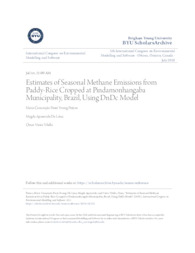Estimates of seasonal methane emissions from paddy-rice cropped at Pindamonhangaba municipality, Brazil, using DnDc Model.
Estimates of seasonal methane emissions from paddy-rice cropped at Pindamonhangaba municipality, Brazil, using DnDc Model.
Author(s): PESSOA, M. C. P. Y.; LIMA, M. A. de; VILELLA, O. V.
Summary: Agricultural activities have been pointed out as one of anthropogenic sources of greenhouse gas emissions, which influence on climatic changes. Information available at Intergovernmental Panel on Climatic Changes (Ipcc) indicated that methane emissions (CH4) generated during the paddy-rice culture development phases is one of these activities and must be better investigated at field conditions. Computer tools that allow following the space-time dynamic of methane emissions from paddy-rice culture, considering the management involved, should also contribute to identify alternatives in order to minimize the high emission rates. Thereby, the Denitrification-Decomposition model (DnDc) can be used to investigate alternative scenarios in order to understand the paddy-rice methane emission process and to identify the critical points. However, DnDc validation is necessary to assure the reliability of those scenarios. Paddy-rice data collected during the seasons of 2004/2005 and 2005/2006 at Pindamonhangaba municipality, São Paulo State ? Brazil, from Agrogases and Carboagro Projects, made possible to compare the quantified seasonal methane emissions from field with those estimated by the DnDc (version 8.9) scenarios. The DnDc/quantified seasonal methane emission rates reached were 0.99 for 2004/2005 and 0.70 for 2005/2006. On average, DnDc estimated the methane emissions 84.6 ± 14.6% close to those quantified from field.
Publication year: 2010
Types of publication: Paper in annals and proceedings
Unit: Embrapa Environment
Keywords: Efeito Estufa
Observation
Some of Embrapa's publications are published as ePub files. To read them, use or download one of the following free software options to your computer or mobile device. Android: Google Play Books; IOS: iBooks; Windows and Linux: Calibre.
Access other publications
Access the Agricultural Research Database (BDPA) to consult Embrapa's full library collection and records.
Visit Embrapa Bookstore to purchase books and other publications sold by Embrapa.

